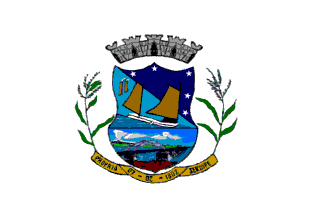 image by Joseph McMillan
image by Joseph McMillan
Last modified: 2008-08-09 by ian macdonald
Keywords: sergipe | propria | coat of arms | bridge | canoe | southern cross |
Links: FOTW homepage |
search |
disclaimer and copyright |
write us |
mirrors
The flag of Propriá was designed in 1978 by the sculptor and painter Antônio
Batista Filho, known as Antônio Januário, and unanimously approved by the
municipal legislature. The flag is white, symbolizing the rice that is the
main agricultural product of the area, with the coat of arms. The shape of
the shield is a series of arcs, inspired by the arches of the bridge that
stands near Propriá. It is divided into three parts representing the
geographic structure of the municipality: Urubu de Baixo [Lower Urubu],
Urubu de Cima [Upper Urubu] and Curral Falso. In the center, a sailing canoe
with its sails open represents the commercial traffic from Propriá throughout the lower São Francisco
valley. (The city of Propriá has the largest sailing canoes on the lower São Francisco,
two of which have a special place in the city's history: the Marialva, which carried
the image of Our Lord of the Navigators in religious festivals, and the Canindé,
known for its large capacity--up to 1,200 rice sacks of 60 kg each--the largest canoe on the lower São
Francisco.) Above the canoe are two chimneys, symbolizing the rice processing factories.
In the upper portion of the shield are five stars representing the Southern Cross (Cruzeiro do Sul).
The five stars also symbolize the five settlements of the municipality: São Miguel,
Santa Cruz, Boa Esperança, Coité, and São Vicente. In base, the symbol of the future of
the municipality, is the bridge. The silver crown, besides being the symbol of a city, is also
intended to represent the military camp where local reservists are trained.
The scroll reads "Propriá--07-02-1802-- Sergipe," 7 February 1802 being the date of Propriá's
establishment as a municipality.
Source:
www.cidadepropria.hpg.com.br/bandeira.htm.
Joseph McMillan, 22 August 2002